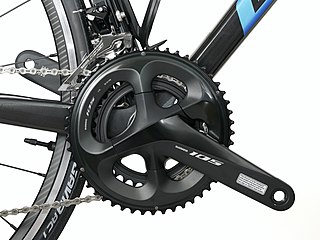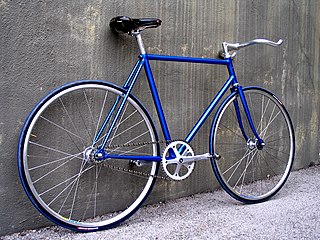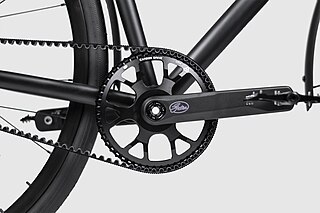

Retro-direct is a gearing mechanism used on some bicycles in the early 20th century, which provides a second gear ratio when pedaled backwards.


Retro-direct is a gearing mechanism used on some bicycles in the early 20th century, which provides a second gear ratio when pedaled backwards.
Retro-direct was developed by French inventor Paul de Martin de Viviés (1833–1911).[ citation needed ] An early two-chain version was patented by in 1869 by Barberon and Meunier. [1] A single-chain version was patented in 1903 by the bicycle manufacturer Hirondelle. [1] Some hobbyists have converted modern bicycles to use retro-direct gearing.
In the single-chain system, the chain runs from the top of a chainring attached to the cranks to the top of a sprocket attached to the rear wheel hub with a freewheel, as with most bicycle chain drives. The chain then, usually, wraps around the rear sprocket to an idler sprocket between the rear wheel and the cranks, then runs back to a second sprocket attached to the rear wheel with a second freewheel, and finally returns to the bottom of the chain ring. Other configurations are possible, including one chain for forward pedalling, and a second crossed-chain configuration for reverse pedalling. Only one freewheel is engaged at a time, while the other spins backward freely. Since the chain wraps around the second sprocket in the opposite direction to the first sprocket, the cyclist needs only to pedal backwards to engage it. The small amount of out-of-line required of the chain is easily accommodated. The rear wheel cannot rotate backwards because the two freewheels try to drive the pedals forward and backward at the same time.
Usually the second sprocket is larger, which provides the cyclist a lower gear for climbing steep inclines simply by pedaling backwards. While most historical examples of retro-direct bicycles used the reverse gear for climbing, several modern retro-direct riders prefer pedalling forward when standing to accelerate from rest and climb, and engaging the higher cruising gear while pedalling backwards.

A bicycle, also called a pedal cycle, bike, push-bike or cycle, is a human-powered or motor-powered assisted, pedal-driven, single-track vehicle, having two wheels attached to a frame, one behind the other. A bicycle rider is called a cyclist, or bicyclist.

A tandem bicycle or twin is a form of bicycle designed to be ridden by more than one person. The term tandem refers to the seating arrangement, not the number of riders. Patents related to tandem bicycles date from the mid 1880s. Tandems can reach higher speeds than the same riders on single bicycles, and tandem bicycle racing exists. As with bicycles for single riders, there are many variations that have been developed over the years.

A derailleur is a variable-ratio bicycle gearing system consisting of a chain, multiple sprockets of different sizes, and a mechanism to move the chain from one sprocket to another.

The crankset or chainset is the component of a bicycle drivetrain that converts the reciprocating motion of the rider's legs into rotational motion used to drive the chain or belt, which in turn drives the rear wheel. It consists of one or more sprockets, also called chainrings or chainwheels attached to the cranks, arms, or crankarms to which the pedals attach. It is connected to the rider by the pedals, to the bicycle frame by the bottom bracket, and to the rear sprocket, cassette or freewheel via the chain.

A bicycle chain is a roller chain that transfers power from the pedals to the drive-wheel of a bicycle, thus propelling it. Most bicycle chains are made from plain carbon or alloy steel, but some are nickel-plated to prevent rust, or simply for aesthetics.

In mechanical or automotive engineering, a freewheel or overrunning clutch is a device in a transmission that disengages the driveshaft from the driven shaft when the driven shaft rotates faster than the driveshaft. An overdrive is sometimes mistakenly called a freewheel, but is otherwise unrelated.

Sturmey-Archer was a manufacturing company originally from Nottingham, England. It primarily produced bicycle hub gears, brakes and a great many other sundry bicycle components, most prominently during its heyday as a subsidiary of the Raleigh Bicycle Company. In the past, it also manufactured motorcycle hubs, gearboxes and engines.

A single-speed bicycle is a type of bicycle with a single gear ratio. These bicycles are without derailleur gears, hub gearing or other methods for varying the gear ratio of the bicycle.

A fixed-gear bicycle is a bicycle that has a drivetrain with no freewheel mechanism such that the pedals always will spin together with the rear wheel. The freewheel was developed early in the history of bicycle design but the fixed-gear bicycle remained the standard track racing design. More recently the "fixie" has become a popular alternative among mainly urban cyclists, offering the advantage of simplicity compared with the standard multi-geared bicycle.

The track stand or standstill is a technique that bicycle riders can use to maintain balance while their bicycle remains stationary or moves only minimal distances. The technique originated in track cycling and is now used by other types of cyclists wishing to stop for a short time without putting a foot on the ground, such as bike commuters at stop signs. To perform a track stand, a cyclist holds the cranks in an approximately horizontal position with the front wheel steered to the left or right, and pedals forward, and back in the case of a fixed-gear bicycle, which the steered front wheel converts into a side-to-side motion.

Gear ratios of bicycles are relative measures of bicycle gearing giving an indication of the mechanical advantage of different gears, which combined with the wheel diameter determines how far the bicycle advances per pedal or crank revolution.

On a bicycle, the cassette or cluster is the set of multiple sprockets that attaches to the hub on the rear wheel. A cogset works with a rear derailleur to provide multiple gear ratios to the rider. Cassettes come in two varieties, freewheels or cassettes, of which cassettes are a newer development. Although cassettes and freewheels perform the same function and look almost the same when installed, they have important mechanical differences and are not interchangeable.

A freehub is a type of bicycle hub that incorporates a ratcheting mechanism.

Bicycle gearing is the aspect of a bicycle drivetrain that determines the relation between the cadence, the rate at which the rider pedals, and the rate at which the drive wheel turns.

A belt-driven bicycle is a chainless bicycle that uses a flexible belt, typically a synchronous toothed design, in order to transmit power from the pedals to the wheel.

Flip-flop hubs, also called double-sided hubs, are rear bicycle hubs that are threaded to accept fixed cogs and/or freewheels on both sides.

Lincoln Motor Car Works was an automobile company in Chicago, Illinois. It produced cars for Sears Roebuck from 1908 until 1912.

Bicycle drivetrain systems are used to transmit power on bicycles, tricycles, quadracycles, unicycles, or other human-powered vehicles from the riders to the drive wheels. Most also include some type of a mechanism to convert speed and torque via gear ratios.
Derived from Ron Shepherd's book The Dancing Chain by Van der Plas Publications.